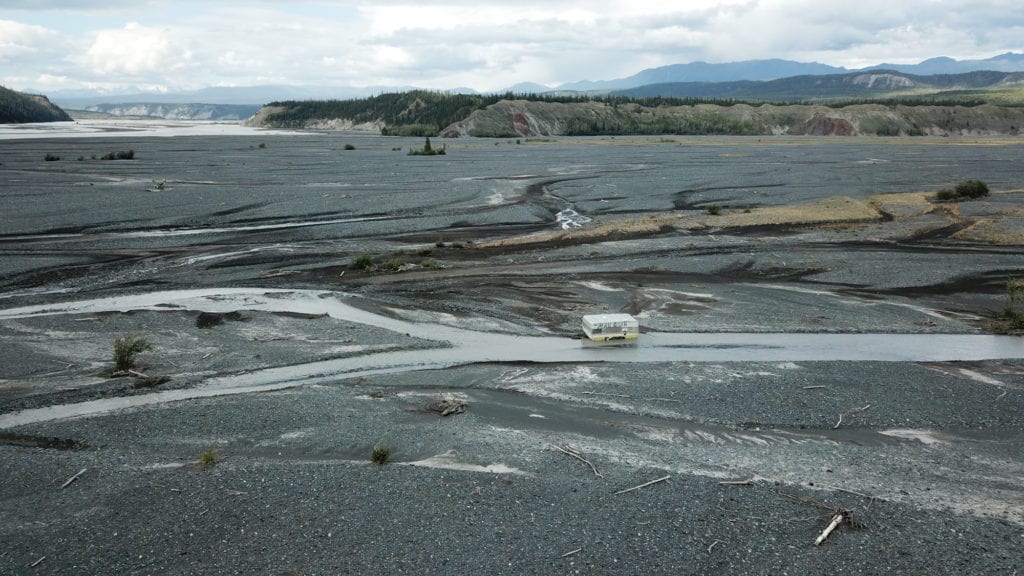
If you’ve ever crossed the Copper River Bridge near Chitina, chances are you’ve noticed several half-buried vehicles, motorhomes and other junk upstream from the bridge, where the Kotsina River joins the Copper River. And chances are if you’ve noticed, you’ve wondered why “someone” hasn’t done “something” about it!
Various local groups have been aware of the problem and looking for a solution for years, but it is a thorny one, with multiple landowners, a meandering river and a huge cost. Legally, responsibility for removing abandoned vehicles falls to the owner, and after 14 days without a permit they are considered to be trespassing. In 2017 the State of Alaska contacted all of the vehicle owners requesting their removal, but received no response.
Why is this project important? As well as being an eyesore, the vehicles contain toxic fluids and materials which are washed into the river as they break apart. They create a hazard to safe boating and enjoyment of the area. And, sadly, junk serves as an invitation for more junk, while a clean environment encourages users to be better stewards of the resource.
Another question we’ve been asked about this project is “Why doesn’t the state or vehicle owners (or someone else) take care of this? Why ask for donations to clean up someone else’s mess?” Yes, someone else should be cleaning it up, but they aren’t! At this point the cost of removal far exceeds the value of the vehicles. The challenges of cleanup and risk to the river increase with time, and we’d just like to be part of the solution.
Copper River Watershed Project has had this on its “wish list” for years, but funding has been a huge barrier. There was a breakthrough this summer, when Dave Cruz of Cruz Construction volunteered to provide machinery and a skilled crew to extract the vehicles. A local property owner, fish wheel operator, and lover of Copper River salmon, Cruz has a construction crew working in the area and saw it as an opportunity to do a public service and help protect the fishery.
With the Cruz Construction offer removing one of the biggest obstacles and many other projects hampered by COVID-19 restrictions, this fall is great timing. The State of Alaska recently issued a permit for the project, and we are in the midst of conversations with other potential partners. WISE is providing local support and organizing a volunteer effort to help with removing debris that can be collected by hand. Last fall a cleanup of popular camping and dipnetting spots in the area yielded two pickup truck loads of garbage.
The meandering Kotsina River, which emerges from a canyon and flows across a wide flood plain before joining with the Copper, is one of the trickiest challenges of the project. For years it was confined to the west side of the floodplain by dikes, making a large area of riverbank upstream from the Copper River Bridge easily accessible. But with the dikes no longer maintained, the Kotsina has rerouted, and the vehicles ended up on the other side, or in some cases right in the channel.
At this point I’m going to diverge a little and explain that the Kotsina River was just doing what rivers do best: carrying sediments, depositing them, seeking low places to flow to, and meandering about on the flood plain. Having been restrained for a while, it was not a surprise that it shifted to the opposite side. For a detailed description of this process and man’s mostly ineffectual quest to manage it, I highly recommend John McPhee’s book “Control of Nature,” with a fascinating section about the Mississippi River and Atchafalaya Basin.
If all goes to plan, the actual removal will take place in late September or early October, when low water levels will make everything easier. The vehicles will be extracted, any remaining fluids removed, and broken into pieces for disposal. We will also remove other debris such as derelict fishwheels. The team is looking into the possibility of recycling some of the metal.
And here is where the “someone” who should do “something” about this mess becomes you! The next big obstacle is finding funding to haul away and dispose of the estimated 50 cubic yards of debris. As well as asking for support from agencies and businesses, we are running a crowdfunding campaign so that everyone who loves the area can pitch in. Links to donate can be found on the WISE website at wise-edu.org and the Copper River Watershed Project website at copperriver.org. You can also donate via text message: text CLEANKOTSINA to 44-321.
Robin Mayo is executive director of Wrangell Institute for Science and Environment.





